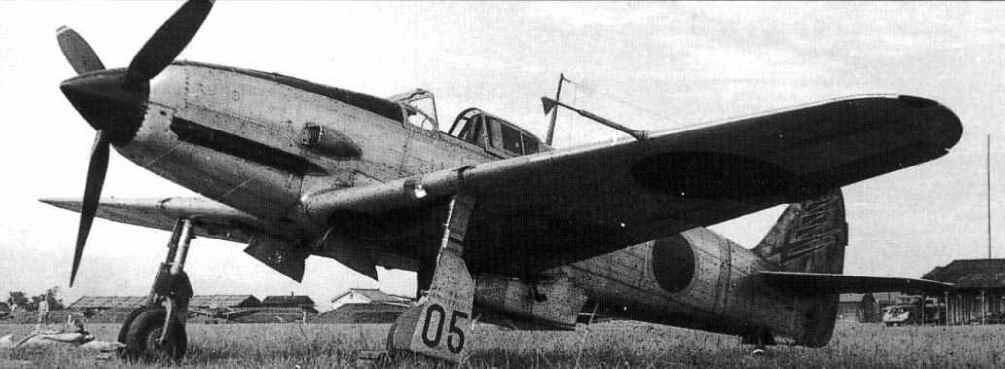Kawasaki Ki-61 Hien 飛燕 - 'Flying Swallow' National origin:- Japan Role:- Fighter Manufacturer:- Kawasaki Kōkūki Kōgyō K.K. First flight:- December 1941 Introduction:- 1942 Retired:- 1945 (Japan) Primary users:- Imperial Japanese Army Air Service, Chinese Nationalist Air Force, People's Liberation Army Air Force Produced between 1940 - 1945:- 3,078 Variants:- Kawasaki Ki-100 The Kawasaki Ki-61 Hien (飛燕, 'flying swallow') is a Japanese World War II fighter aircraft used by the Imperial Japanese Army Air Service. The Japanese Army designation was 'Army Type 3 Fighter' (三式戦闘機). Allied pilots initially believed Ki-61s were Messerschmitt Bf 109s and later an Italian aircraft, which led to the Allied reporting name of 'Tony', assigned by the United States War Department. It was the only mass-produced Japanese fighter of the war to use a liquid-cooled inline V engine. Over 3,000 Ki-61s were produced. Initial prototypes saw action over Yokohama during the Doolittle Raid on 18 April 1942, and continued to fly combat missions throughout the war.
Operational history
The Ki-61 looked so different to the usual radial-engined Japanese fighters that the Allies at first believed it to be of German or Italian origin, possibly a license-built Messerschmitt Bf 109. The first Ki-61 seen by Allied aircrew had been misidentified as a Bf 109 by USAAF Capt. C. Ross Greening during the Doolittle Raid. In early reports, when it was thought to have been a German fighter, the Ki-61 had been code-named 'Mike'. The final, and better known code name adopted was 'Tony', because the Ki-61 looked like an Italian aircraft.
The new Ki-61 Hien fighters entered service with a special training unit, the 23rd Chutai, and entered combat for first time in early 1943, during the New Guinea campaign. The first Sentai (Air Group/Wing) fully equipped with the Hien was the 68th in Wewak, New Guinea, followed by the 78th Sentai stationed at Rabaul. Both units were sent into a difficult theatre where jungles and adverse weather conditions, coupled with a lack of spares, quickly undermined the efficiency of both men and machines. Because the Ki-61 was so new, and had been rushed into service, it inevitably suffered from teething problems. Almost all of the modern Japanese aircraft engines, especially the Ki-61's liquid-cooled engines, suffered a disastrous series of failures and ongoing problems, which resulted in the obsolescent Ki-43 still forming the bulk of the JAAF's fighter capability.
Initially, this campaign went successfully for the Japanese Army Air Force (JAAF), but when the Allies re-organized and enhanced the combat capabilities of their air forces, they gained the upper hand against the JAAF. High non-combat losses were also experienced by the Japanese during this campaign. For example, while in transit between Truk and Rabaul, the 78th lost 18 of its 30 Ki-61s
Even with these problems, there was some concern in Allied aviation circles regarding the Hien:
The new Japanese fighter caused some pain and consternation among Allied pilots, particularly when they found out the hard way that they could no longer go into a dive and escape as they had from lighter Japanese fighters. ...General George Kenney [Allied air forces commander in the Southwest Pacific] found his Curtiss P-40s completely outclassed, and begged for more Lockheed P-38 Lightnings to counter the threat of the new enemy fighter.
However, the increasing numerical strength of Allied bomber units, along with inadequate anti-aircraft systems, imposed crippling losses on Japanese units. Approximately 100 out of 130 Japanese aircraft based in the Wewak area were lost during the attacks of August 17–21 1943. By the end of the campaign, nearly 2,000 Japanese aircraft had been lost in air attacks from up to 200 Allied aircraft at a time, around half of which were Consolidated B-24 Liberators and North American B-25 Mitchells armed with fragmentation bombs. After the Japanese retreat, over 340 aircraft wrecks were later found at Hollandia.
The Ki-61 was also utilised in Southeast Asia, Okinawa, China and as an interceptor during US bombing raids over Japanese home islands, including against Boeing B-29 Superfortresses. The Ki-61 was notable for many reasons: initially identified as of either German or Italian origin, these aircraft were capable of matching Allied aircraft such as the P-40 in speed, and as evaluation had already showed, were superior in almost every respect. However, the armament of the early Hien was lighter, but still sufficient for most purposes. Some authors claim that the Lockheed P-38 Lightning was measurably superior. The Ki-61 carried a great deal of fuel, but due to having self-sealing fuel tanks it was not considered readily flammable, as many other Japanese aircraft were.
 Editor for Asisbiz: Matthew Laird Acred
Editor for Asisbiz: Matthew Laird Acred
If you love our website please donate so we can make this site even better !!

